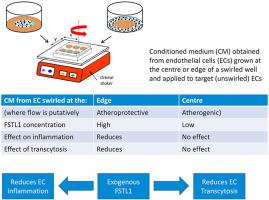Atherosclerosis ( IF 4.9 ) Pub Date : 2021-08-14 , DOI: 10.1016/j.atherosclerosis.2021.08.025 Mean Ghim 1 , Kuin T Pang 1 , Sean A Burnap 2 , Ferheen Baig 2 , Xiaoke Yin 2 , Mehwish Arshad 1 , Manuel Mayr 2 , Peter D Weinberg 1

|
Background and aims
When endothelium is cultured in wells swirled on an orbital shaker, cells at the well centre experience putatively atherogenic flow whereas those near the edge experience putatively atheroprotective flow. Transcellular transport is decreased equally in both regions, consistent with it being reduced by a mediator released from cells in one part of the well and mixed in the swirling medium. Similar effects have been inferred for pro-inflammatory changes. Here we identify the mediator and flow characteristics stimulating its release.
Methods and results
Medium conditioned by cells swirled at the edge, but not by cells swirled at the centre or cultured under static conditions, significantly reduced transendothelial transport of a low density lipoprotein (LDL)-sized tracer and tumor necrosis factor α (TNF-α)-induced activation and translocation of nuclear factor κB (NF-κB), adhesion molecule expression and monocyte adhesion. Inhibiting transcytosis similarly decreased tracer transport. Unbiased proteomics revealed that cells from the swirled edge secreted substantially more follistatin-like 1 (FSTL1) than cells from the swirled centre or from static wells. Exogenous FSTL1 reduced transport of the LDL-sized tracer and of LDL itself, as well as TNF-α-induced adhesion molecule expression. Bone morphogenetic protein 4 (BMP4) increased transport of the LDL-sized tracer and adhesion molecule expression; FSTL1 abolished these effects.
Conclusions
Putatively atheroprotective flow stimulates secretion of FSTL1 by cultured endothelial cells. FSTL1 reduces transcellular transport of LDL-sized particles and of LDL itself, and inhibits endothelial activation. If this also occurs in vivo, it may account for the atheroprotective nature of such flow.
中文翻译:

暴露于动脉粥样硬化保护流的内皮细胞分泌卵泡抑素样 1 蛋白,可减少转胞吞作用和炎症
背景和目标
当在轨道摇床上旋转的孔中培养内皮细胞时,孔中心的细胞经历推定的动脉粥样硬化流动,而靠近边缘的细胞经历推定的动脉粥样硬化保护流动。跨细胞转运在两个区域均减少,这与它被从孔的一部分中的细胞释放并混合在旋转培养基中的介质减少一致。已经推断出促炎变化的类似效果。在这里,我们确定了刺激其释放的中介和流动特征。
方法和结果
由在边缘旋转的细胞而不是在中心旋转或在静态条件下培养的细胞调节的培养基显着降低了低密度脂蛋白 (LDL) 大小的示踪剂和肿瘤坏死因子 α (TNF-α) 诱导的经内皮转运核因子 κB (NF-κB) 的激活和易位、粘附分子表达和单核细胞粘附。抑制转胞吞作用同样会降低示踪剂的转运。无偏见的蛋白质组学显示,来自漩涡边缘的细胞比来自漩涡中心或静态孔的细胞分泌更多的卵泡抑素样 1 (FSTL1)。外源性 FSTL1 减少了 LDL 大小的示踪剂和 LDL 本身的转运,以及 TNF-α 诱导的粘附分子表达。骨形态发生蛋白 4 (BMP4) 增加了 LDL 大小的示踪剂的转运和粘附分子的表达;
结论
推定的动脉粥样硬化保护流动刺激培养的内皮细胞分泌 FSTL1。FSTL1 减少 LDL 大小的颗粒和 LDL 本身的跨细胞转运,并抑制内皮活化。如果这也发生在体内,它可能解释了这种流动的动脉粥样硬化保护性质。











































 京公网安备 11010802027423号
京公网安备 11010802027423号